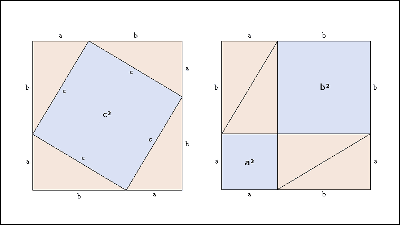Five mathematical phenomena that researchers say 'show the beauty of mathematics'

Mathematics exists everywhere in nature, such as the shape of a shell, the flow of a river, and the whirlpools of a galaxy. Thomas Blitz, a lecturer in the Department of Mathematics and Statistics at the University of New South Wales, who has loved mathematics since he was a child and says that 'beauty is mathematical in itself,' lists five things in our daily lives that show the connection between mathematics and beauty.
The mystique of mathematics: 5 beautiful math phenomena
◆1: Symmetry

In a lecture in 2018, Blitz
For example, people perceive a symmetrical face as 'beautiful,' but if there is something that slightly disrupts the symmetry, it adds to the 'beauty' as an attractive feature.
The same can be said about music, where the combination of unexpected elements with regular, patterned sounds gives it character, charm, and depth.
Similar harmonies exist in many mathematical concepts, such as 'pattern and unexpectedness,' 'elegance and chaos,' and 'truth and mystery,' Blitz said.
◆2: Fractal
A fractal is something that has self-similar parts and a whole. The vegetable Romanesco is one of the fractals we often see in our daily lives, and the closer you get to Romanesco, the more you can see the same shapes being repeated.

Such fractal structures can be found everywhere in nature, including snowflakes, rivers, flowers, trees, and blood vessels.
While the layers of fractals we see in nature are finite, conceptually, the layers of fractals are infinite: 'When you do a computer simulation, you can't see the end of the fractal, no matter how close you get,' Blitz says.
◆3:
In mathematics, 'π' is simply a number slightly larger than 3. π is used to calculate the perimeter and area of a circle, but in fact, the concept of π is 'more than that,' says Blitz.
'If you look at nature, you'll find pi everywhere, not only in things that have to do with circles, but also in formulas for probability and calculus, things that have nothing to do with circles at all,' he says. Despite being the most famous number, pi seems shrouded in mystery.
By definition, pi is infinite, and all numbers are unknowable. Also, as of 2020, no patterns have been found after the decimal point, so your birthday and phone number are also somewhere in pi.
You can use the following website to find out where your phone number lies on the scale of pi.
Irrational Numbers Search Engine
http://www.subidiom.com/pi/

At the time of writing, the known value of pi is up to 50 trillion digits. Since no one knows the exact value of pi, it is impossible to calculate the exact area of a circle, but it is possible to approach that value. Regarding the number pi, which is associated with circles all over the world, Blitz said, 'We understand some of the truths of pi, but we don't understand pi itself. This mystery creates beauty.'
◆4: Golden ratio
The most famous ratio related to beauty is the golden ratio, which is said to be 'the most beautiful way to arrange objects.'
The golden ratio is an irrational number that continues as '1.6180339887 ...', so it is usually shortened to '1.618'. The golden ratio can be represented geometrically and visually as a curve and a rectangle as shown below.
'Historically, this ratio has been used as a benchmark of 'ideal form' in architecture, art and the human body. I call it the Divine Proportion, and famous artworks, including those of Leonardo da Vinci , are based on this ratio,' Bridge says.
The golden ratio is still used today in a wide range of fields, including art, design, and photography. In 2014, it was revealed that the head of Sonic the Hedgehog, a Sega character, was made in the golden ratio.

◆5: Banach-Tarski paradox
The Banach-Tarski paradox is a theorem that says, 'If you divide a sphere into several parts and rearrange them, you can make two balls of the same size as the original sphere.' In reality, it is impossible to make two balls of the same size from the ball you have at hand, but mathematically it is possible, and Bridge says, 'In a sense, this is magic.'
The five mathematical concepts above are only a part of the beauty of mathematics. 'To see the beauty of a lot of mathematics, you need background knowledge. It requires basic, boring training, like an athlete doing push-ups over and over again, but it's worth it. I hope that more people will be able to enjoy mathematics more. There is a lot of hidden beauty here,' Bridge said.
Related Posts:
in Science, , Posted by darkhorse_log







